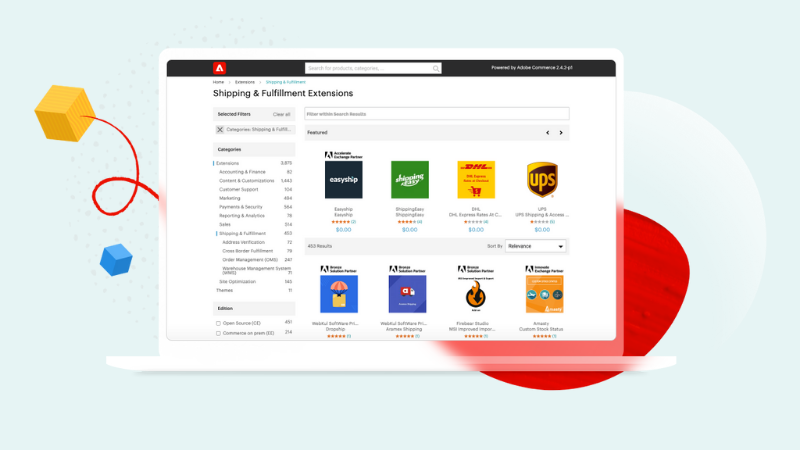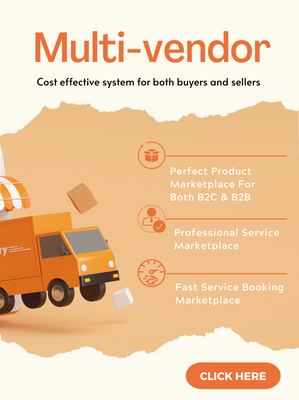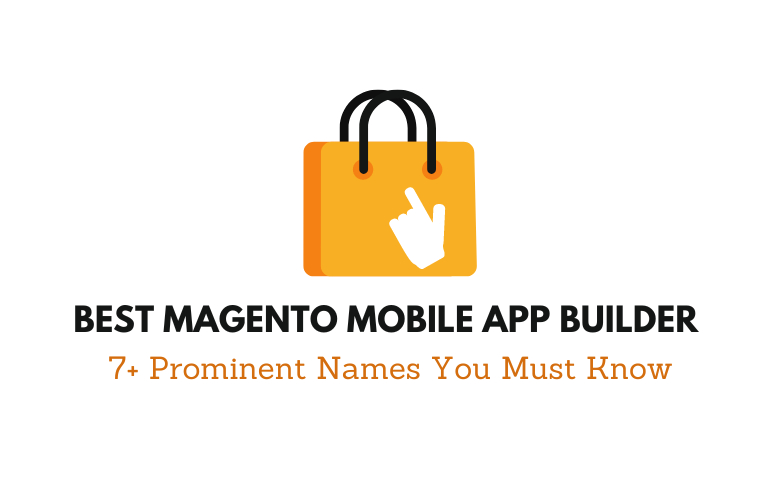Your cart is currently empty!
Why Adobe Commerce is a powerful solution for B2B eCommerce merchants
Business-to-business electronic commerce, or B2B eCommerce, sells goods and services between businesses online. Initially, B2B businesses haven’t intended to take up eCommerce. But, in recent years, especially after the COVID-19 pandemic, the B2B eCommerce space has been growing markedly. As a result, buyer expectations are growing higher than ever before.
Therefore, if you desire to succeed in this developing digital marketplace, you should bring about more than essential B2B buying experiences. Above vital needs, customers expect a “feature-rich” digital experience, which would hardly be met by applying Magento Open Source. This eCommerce platform has been used by thousands of companies and has become too familiar.
Nowadays, Adobe Commerce, an integration of Adobe and Magento, can satisfy you and your customers. It frees you from many tasks and has many pre-built features specially designed for B2B commerce. This means you can quickly add next-generation B2B e-commerce functionality while spending less to maintain your platform. Let’s get started and uncover details about what Adobe Commerce is. Then we will dive into why Adobe Commerce is a mighty solution for B2B commerce businesses.
What is Adobe Commerce?

Earlier, Adobe is known as a platform helps create and publish photos and graphics. But, since Adobe engaged in the eCommerce market, it has created wonderful digital experiences that convert into substantial revenues.
Magento Commerce, one of the leading eCommerce platforms, was renamed Adobe Commerce. It is a collection of the best tools and technologies of both Magento and Adobe put in one platform – an outstanding B2C and B2B eCommerce platform and an effective CMS.
In 2018, it acquired one of the leading eCommerce platforms called Magento Commerce to integrate it with Adobe Experience Cloud (an Enterprise CMS platform by Adobe). The sole purpose behind this was to provide companies with an all-in-one platform for creating and offering great digital experiences.
Reasons why Adobe Commerce is mighty for B2B businesses
>>> Related post : Why Adobe commerce cloud is suitable for multichannel sales
1. Efficient in-built B2B functionalities in Adobe Commerce
Setting up and managing company account
- Companies may quickly design specific buyer roles, shipping choices, and approval procedures with the aid of self-service tools.
- With self-service order, credit, quotation, and invoice monitoring, it is easier to market to companies with tiered hierarchies.
- Increase sales by taking payments via many channels such as PayPal, credit cards, and others.
Selling on multiple channels
Controlling a business that sells through multiple channels is a hard task. Knowing this, Adobe allows merchants to take control of their channel partners, their brands, and customers from only one interface.
- You may also use selling models that provide built-in support for marketplace extensions.
- On a single dashboard, you may manage hundreds of categories and over one million goods.
- For a better experience, you may also create new users and segment-specific catalogs.

Advanced capabilities for creating wonderful B2B experiences
- You can customize the price lists, promotions, and catalogs. All rely on the types of customer groups you focus on.
- Offer automatic up-sell and cross-sell capabilities to enterprises.
- Multiple business revenues with fast ordering (you can upload a CSV file or enter SKUs, or simply copy last orders).
- With GraphQL APIs, you can create strong headless B2B interfaces for commerce.
Owing to those capabilities, companies increase productivity by delivering a consistent experience to their B2B buyers across several locations via a single platform. By automating processes and offering your B2B clients experiences they will like throughout their purchase journey, you can focus on the growth of your B2B business rather than on IT. It also allows you to simply interact with backend systems via APIs and retrieve the relevant data in real-time.
2. Suitable for a Hybrid Business model
The hybrid business model combines traditional product sales with subscription-based hardware, software, cloud solutions, and other services.
Managing both B2B and B2C shops at the same time is impossible, especially when using a platform that does not support both. Having this by using Magento Open Source will be time-consuming and costly. Adobe Commerce, on the other hand, is ideal for hybrid enterprises since it can:
- Streamline the technology with flawless maintenance processes
- One admin can take charge of multiple stores and products by himself
- Quickly bring new B2B and B2C products into the market
- Constant, branded B2B and B2C experiences
- Optimize company strategy by integrating data from all of your commerce activities.

3. Up-to-date and secure architecture
Upgrading to Adobe Commerce, which is designed on a modern and secure framework, is an ideal decision. This is because it helps preserve your brand’s name and image while also keeping the site safe.
Merchants must stay up with quickly evolving technology by constantly upgrading their e-commerce shops. Many are still using Magento Open Source. But they are not aware that it is based on 10-year-old technology. This platform is more prone to security risks and breaches than Adobe Commerce updated technological solutions.
If you are still using the Magento 1 version, it is now the most dangerous e-commerce platform to utilize. Its security updates had expired roughly 1.5 years prior. Using it indefinitely while failing to upgrade the store to Magento 2 or Adobe Commerce might be harmful.
4. The optimal option for Amazon business
Amazon has grown to become the top eCommerce platform in the world. Each month more than 197 million people around the world use their devices to surf Amazon.com. As reported, approximately 75% of B2B buyers surveyed said that they research Amazon business. Besides, 50% of them plan to increase their spending on Amazon in 2023.
But, easier said than done, selling on Amazon is not that easy. On running a store on Amazon, many merchants said that they had had to deal with a lot of problems, such as system integrations, off-the-shelf connectors, etc.

Thanks to Adobe Commerce, everything now is handy. Adobe Commerce’s Amazon Sales functionality offers a useful, easy, and cost-effective method to sell on Amazon. Further, it allows you to sell on Amazon in many distinct ways:
- Manual labor is no longer required.
- There is no need for system integration or maintenance.
- Inventory management and Fulfillment Synchronization of Data.
- Make more right and timely fulfillment selections.
- Price should be optimized in order to make better and faster pricing decisions.
5. Adobe Commerce helps build an Amazon-like marketplace
In this modern age, about 90% of the B2B buyers shop in the B2B space. Like selling on the Amazon marketplace, it’s time for you to develop your marketplace. Today, nearly 87% of the B2B buyers shop on B2B marketplaces on a regular basis. And by 2023, at least 70% of the enterprise marketplaces will deliver B2B transactions.
Creating a marketplace is much simpler than you think, and many B2B companies have already begun to chase this path. A marketplace needs the use of a specific platform in order to offer a great user experience.
Adobe Commerce is a good marketplace platform as it is flexible, and secure, and has excellent features as well. It also integrates well with other marketplace software products. Building a market with a free, open-source platform will lack the required security and functionalities.
6. Higher Return On Investment rate (ROI)
There is a common belief that upgrading your store from Magento Open Source to Adobe Commerce can be costly. But, some studies have shown that companies having swapped to Adobe Commerce had achieved an average ROI (Return on Investment) of 165.3% after just three years. This notable achievement can be ascribed to:
- The conversion rates grew by 16%
- The site traffic increased by 25%
- An increase of 29% in the mobile revenues
- The average order value increased by 5%
- Costs of content making decreased by nearly 70%
- Downtime dropping by 93%
7. Ability to combine with ERP Software
Connecting your eCommerce platform to your ERP system (Enterprise Resource Planning) helps you provide a better consumer experience while also gathering critical company analytics. When your ERP software accesses your shop data, you can have a general overview of your company’s entire performance.

8. Smooth mobile experience
In B2C business, above 65% of the customers use their mobile gadgets to find online stores. As for the B2B business, the numbers are also increasing for the B2B merchants and buyers as well. It is obvious that even B2B buyers like to shop anywhere and anytime. As a result, it is vital for the online store to have a mobile presence.
Adobe Commerce offers mobile-first design and also includes PWA development. Progressive Web Applications (PWAs) are websites that can provide users with an app-like experience.
There are many applications of PWA in B2B business. For instance, customers can get push notifications of their current order status, as well as other reminders. Besides, PWAs allow users to scan a bar code with their own device in order to reorder a product.
9. Adobe Commerce can work with loads of extensions
In building a website with Magento Open Source, you may have to add a lot of extensions. Also, those extensions are not always well-matched with Magento versions. Therefore, the risks involved in running the store arise.
As compared to Magento Open Source, Adobe Commerce features are in-built. This benefit reduces the demand for 3rd party extensions. Further, it helps businesses reduce a great amount of money spent on improving functioning.

10. Expandability
Lastly, expandability is a crucial requirement for B2B businesses. With Magento Open Source, you will have to take the charge of managing your infrastructure. This process can be tough and pricey as well. Also, you have to partner with many suppliers and keep track of plenty of things. But, Adobe Commerce will allow you to boost your performance after the traffic growth, capacity on-demand, and results-based pricing.
Adobe Commerce also supports API (Application Programming Interface) interaction with other order management applications. So, if a company wants to keep using the old OMS, integrating it with Adobe Commerce is quite simple.
With Magento platform as a groundwork for Adobe Commerce, it allows smooth integration of various CRM applications via APIs. This degree of integration might be as simple as adding an extension. Likewise, it can be as complex as developing a bespoke integration using SOAP (Simple Object Access Protocol) or REST APIs (Representational State Transfer). In the long run, these sorts of connections positively enhance customer experience and more sales.
11. E-Commerce content management
Adobe Commerce page builder is a useful tool. It allows businesses to quickly construct new pages without touching a single line of code. Thus, merchants can build personalized landing pages, FAQ pages, product detail pages, … to conduct efficient marketing campaigns and increase sales.
It is crucially a WYSIWYG (What You See Is What You Get) editor that is fully codeless, allowing even a marketer to quickly design and deploy sites. The page builder tool is strong, user-friendly, and very adaptable. Also, it has many drag-and-drop pieces that perform all of the hard work for marketers. It helps marketing teams create compelling content pages that generate sales and, as a result, a considerably higher ROI.
For instance, one of the peak seasons in the year is Christmas. During that period, your development team can be busy improving website speed and dealing with increased traffic. But, your marketing team won’t have to rely on them to create eye-catching and elegant landing pages. Alternatively, if you, as an admin, wish to expand your product offering, you don’t have to rely on your IT staff. Simply drag and drop text, images, buttons, and other elements as needed to complete the task.
Wrapping up
In short, this post has uncovered some effective capabilities that make Adobe Commerce the most powerful solution for B2B businesses. We hope that you will have a better grasp of Adobe Commerce and its use in growing B2B companies.
If you are a B2B company and looking for an experienced and trustworthy unit that can help apply Adobe Commerce, come to us. As an Adobe Magento partner, we – Magesolution provide comprehensive Magento solutions, including Magento PWA, Magento Multi-Vendor, Magento Page Builder, …. Feel free to CONTACT US now for a free consultation!



